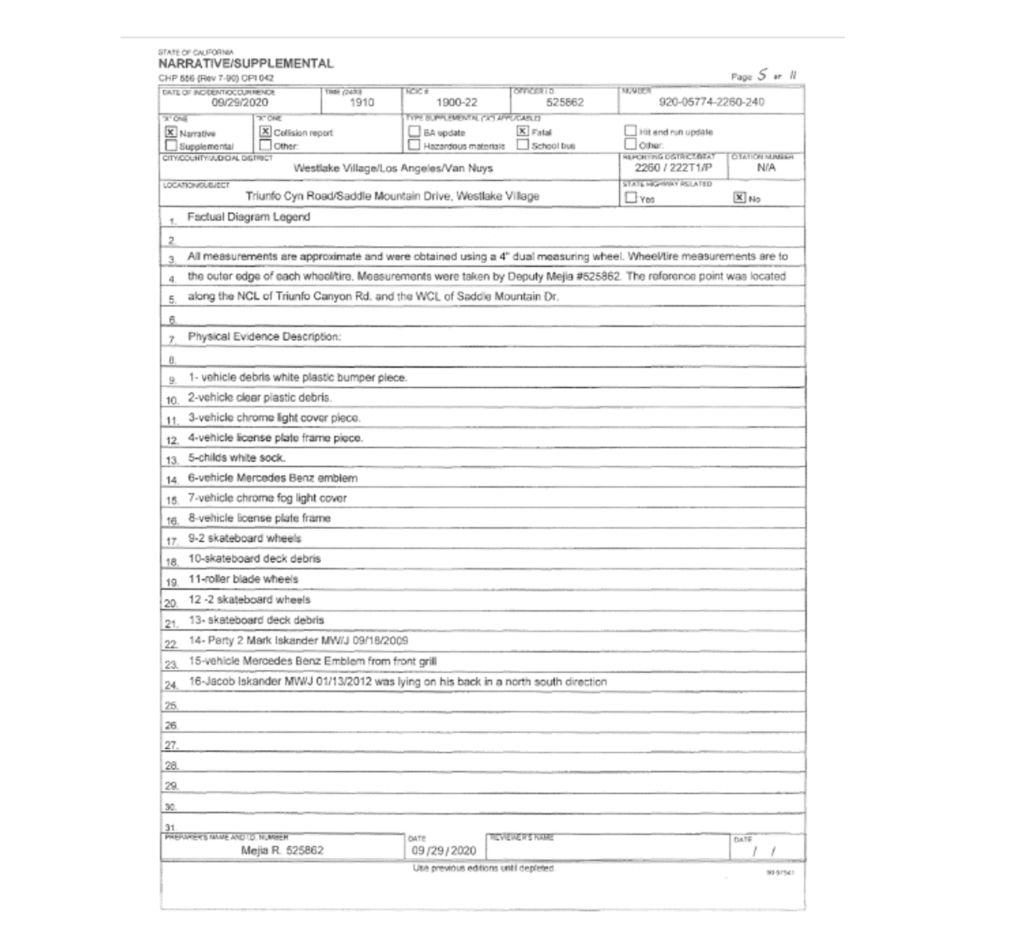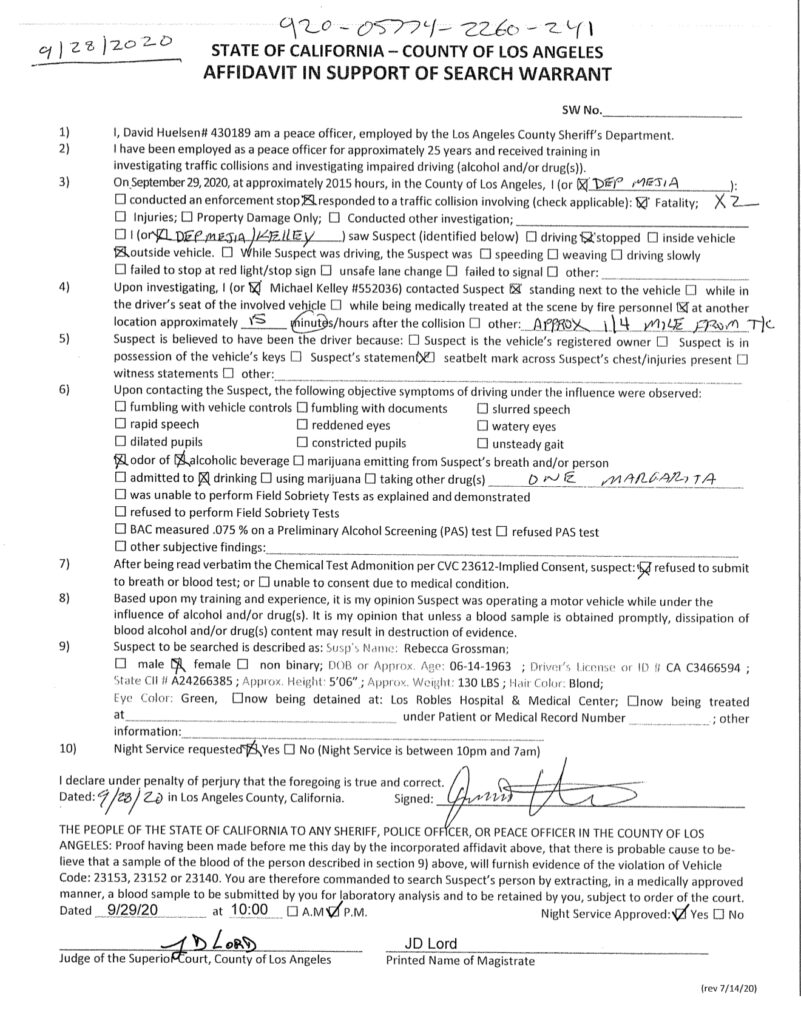Shortly after sunset on Tuesday, September 29, 2020, the quiet streets of Westlake Village became the backdrop for a tragedy that ignited a media firestorm, and now, exposes a deeply flawed investigation.
At exactly 7:10 PM, 11-year-old Mark and 8-year-old Jacob Iskander were struck and killed, allegedly while crossing Triunfo Canyon Road at Saddle Mountain Drive. Yet, with the exception of the youngest child’s scooter, which lay near the crosswalk, the trail of debris didn’t begin until more than 40 feet past the tragic accident scene.
Within hours, headlines branded philanthropist Rebecca Grossman as the sole villain in a horrific tale of speed and recklessness. But nearly five years later, that narrative, carefully curated by law enforcement, mainstream media and local activist Julie Cohen who founded the “Justice for Mark and Jacob Iskander” Facebook page, is beginning to crack.
Behind the scenes, the case reeks of tunnel vision, compromised evidence, and one glaring omission: the black SUV driven by former MLB pitcher Scott Erickson, traveling just three seconds ahead of Grossman in the same lane, was never properly investigated. His vehicle wasn’t photographed or impounded. Erickson wasn’t questioned with any meaningful scrutiny. Instead of a comprehensive, multi-vehicle inquiry, investigators handed the public a tidy story built on selective evidence and half-truths, anchored around one woman, while others sped away untouched.
Multiple witnesses reported hearing two distinct impacts that night, spaced three to five seconds apart. Grossman’s white Mercedes SUV came to a stop nearly a third of a mile down the road, with its emergency response system automatically triggered by the collision. Just ahead of her, Erickson continued down the #2 lane at a high rate of speed.
Here is the video from a private home security camera showing the vehicles in the same lane, in a “high-speed convoy” moments before impact, as reported by witnesses.
Grossman’s airbags deployed and she pulled over, visibly shaken. The impact triggered the Mercedes emergency system and told the operator, and Deputy Rafael Mejia, the first officer on scene, that she didn’t know what she had hit. She repeated that multiple times.
But the narrative was already locked in. Mejia placed her in the back of his radio car and called in a DUI unit. From there, the night unraveled into a cascade of investigative failures.
The scene descended into chaos, becoming a sloppy, one-sided spectacle. Eyewitnesses, including Susan Manners, told deputies they saw a pack of cars speeding down the road, describing white and gray vehicles in what looked like a high-speed convoy. Instead of investigating the obvious possibility of multiple vehicles being involved, those statements were conveniently ignored or buried. Deputies zeroed in on Grossman, and Grossman alone.
One witness reported seeing a scooter in the roadway, a detail that could indicate the point of impact. But that scooter appears in multiple scene photographs in different positions, suggesting it was moved before being documented. That makes it nearly impossible to determine where the children were struck, or how the collision unfolded.

Even more alarming: Detective David Huelsen, who took command of the scene despite being outranked by Sergeant Travis Kelly, reportedly trampled through evidence, issued conflicting instructions, and conducted a haphazard investigation of the crash site, asking on video “how the fuck does it get here and then all the way over there” referring to the debris field.
Sources say Detective David Huelsen was a “political appointee” of disgraced former Lost Hills Captain Tom Martin notorious for concealing jail security footage in the Mitrice Richardson case. Martin’s record is further tainted by serious allegations and an internal investigation into accusations that he raped multiple young women he targeted as they exited local rehab facilities during his tenure at the station.
According to sources, Huelsen was selected by Martin precisely because he could be “controlled.” Despite being assigned to high-stakes cases, Huelsen reportedly lacked experience in accident investigations and was known to lean heavily on other deputies when handling complex or fatal incidents.
“He had no business leading a case like this,” said one source with direct knowledge of Huelsen’s track record. “We had to clean up some serious messes. We all hoped he’d get better with time, but there just wasn’t much room for improvement. I’m quite sure the investigation was a complete shambles. If someone competent wasn’t shadow investigating, there’s no way it was done correctly.”
The official evidence log from the night of the fatal crash on September 29, 2020, reveals an overlooked but critical detail: two items recovered from the scene, a chrome fog light cover and a license plate frame, did not match Rebecca Grossman’s white Mercedes SUV. These pieces, listed in Deputy Rafael Mejia’s supplemental narrative under entries #7 and #8, were collected as part of the physical evidence along Triunfo Canyon Road. Specifically:
- Item 7: “vehicle chrome fog light cover”
- Item 8: “vehicle license plate frame”
Neither of these components are consistent with the design or specifications of Grossman’s car, which raises the obvious question: To which vehicle did they belong?
Witness accounts and scene observations indicate multiple vehicles were involved in what was described as a “high-speed convoy”. The presence of vehicle debris not traceable to Grossman supports the theory of multi-vehicle involvement, yet authorities never pursued that line of inquiry.
Even more troubling: both the fog light cover and the license plate frame disappeared from the evidence chain. Despite being catalogued at the scene, neither item appears in subsequent forensic or evidentiary reports. No explanation has been provided for their disappearance.
This isn’t just an oversight, it’s potential evidence tampering or at the very least, gross negligence. These items could have identified another vehicle directly involved in the crash or corroborated witness statements describing multiple cars barreling down the road in tandem. Their disappearance effectively shields those other drivers from scrutiny and reinforces the one-sided focus on Grossman.
The missing parts not only suggest other vehicles were involved, but highlight a deeply compromised investigation, one where critical evidence simply vanished and the truth was buried along with it.

While the public was sold a headline-friendly DUI narrative, the actual case file tells a far more troubling story. Grossman submitted to two breath tests at 8:52 PM. Her Preliminary Alcohol Screening (PAS) results were 0.076% and 0.075%, both under California’s 0.08% legal limit. Yet this critical fact was left out of most media coverage and conveniently ignored by prosecutors, despite being central to the DUI claim.
Detective Huelsen falsely reported that Grossman refused a separate chemical breath test, a claim disproven both at her DMV hearing and at the criminal trial. In reality, a formal post-arrest chemical breath test, typically administered at the station, was never offered. Grossman only refused an on-site blood draw, citing a medical condition. She had the legal right to decline without consequence. But that refusal was twisted into a lie, used to secure a forced blood warrant in violation of her Fourth Amendment rights.

That falsehood, embedded in official records, tainted the entire process. Grossman was never charged with DUI, yet the prosecution used the fabricated narrative of impairment to support an implied malice theory, which ultimately led to her conviction for second-degree murder.
This wasn’t just a case of tragic loss, it was a miscarriage of justice, built on manipulated facts, missing evidence, and law enforcement’s refusal to look beyond their chosen suspect.
The blood vial collected at Los Robles Hospital was missing a name label. No personnel signature. No proper documentation and stuffed in a cabinet at the Lost Hills Station for days until sent to the LA crimes lab. All of which is a clear violation of chain of custody and proper procedure That’s a chain-of-custody disaster, yet it remains a cornerstone of the prosecution’s evidence.

While sitting in the back of Deputy Mejia’s cruiser, Grossman was interrogated without being read her Miranda rights, a fact acknowledged in the incident reports. In a fatal criminal case, that’s not just a procedural misstep, it’s a constitutional failure.
That same night, Carl Koenig, manager of The Boat House, was contacted by the Lost Hills Station to review surveillance footage from one of three available cameras. Approximately four or five deputies initially entered the premises and filmed the footage directly off the monitor. Later that night, another group of four deputies returned and did the same, recording the footage on a cell phone instead of requesting a copy or download. The lead investigators in the case never asked The Boat House to save or preserve the original footage effectively allowing a key piece of evidence to vanish.
The video showed two cars ahead of Erickson, Erickson directly in front of Grossman, and at least three additional vehicles following behind her. Yet, despite multiple vehicles clearly involved, only Grossman stopped, only Grossman was questioned, and only Grossman was arrested.
Sergeant Travis Kelly’s jailhouse interview with Rebecca Grossman was anything but routine. From the moment it began, the tone was laced with hostility, his demeanor brimming with vitriol, impatience, and what appeared to be a pre-formed conclusion of guilt. Instead of calmly collecting facts or clarifying the chaotic series of events that unfolded that night, Kelly launched into the interaction with an accusatory tone and emotionally charged language that suggested he had already made up his mind.
There was no effort to preserve neutrality or probe for facts, just a rush to judgment. His line of questioning was less about gathering information and more about cornering Grossman, pushing a narrative that hadn’t yet been substantiated by physical evidence. The aggression in his tone, paired with his visible frustration, suggested a personal bias rather than an objective approach to a thorough homicide investigation.
Grossman, visibly shaken, repeatedly said she didn’t know what she hit. Instead of acknowledging her confusion or shock, Kelly interpreted it as defiance. The lack of compassion, the accusatory posture, and the emotional intensity he brought into the room all contributed to what now appears to be a coercive, prejudicial interview that further undermines the integrity of the investigation.
In a case already marked by missing evidence, investigative shortcuts, and unequal treatment of involved parties, Deputy Kelly’s interview stands out as a moment where law enforcement abandoned professionalism for presumption.
When looking at the case objectively, without media bias, it is clear the investigation was never about the truth, it was about optics during a politically contentious time. And in this case, law enforcement chose their target early and worked backward. Despite being three seconds ahead in the same lane, Scott Erickson’s vehicle was never examined, never impounded, never entered into evidence. The public was shown a photo of a different black Mercedes, falsely presented as the vehicle Erickson was driving that night, on Fox 11. Not only was the wrong vehicle aired, no correction was ever made.

That’s not just sloppy, it’s intentional.
This case was supposed to deliver justice to the Iskander family. But what it delivered instead was a public crucifixion based on broken procedures, buried evidence, and a media eager to pounce. Justice isn’t one-sided. Justice isn’t what fits best into a press release. And justice isn’t ignoring the lead driver, in the same lane, seconds ahead, and witness statements hearing multiple impacts, in order to build a case on flawed evidence and politically convenient lies.
The two lead investigators on the night of the crash, the very ones who interrogated Rebecca Grossman and had the most direct, contemporaneous knowledge of the case, were never called to testify at trial. As I continue to investigate, a key question remains: Was this omission a deliberate decision by District Attorney George Gascón’s office to shield the prosecution from exposing a deeply flawed and biased investigation?





Follow Us